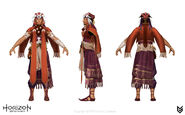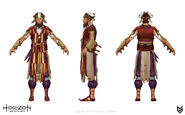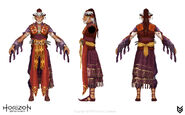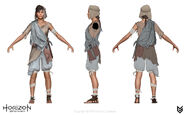The Carja (also referred as the Sun Carja to differentiate themselves from their splinter tribe) are an advanced and powerful human tribe in Horizon Zero Dawn.
The Carja are ruled by a monarch, Sun-King Avad, and are currently engaged in a civil war. They have a vast population and are more advanced economically and militarily compared to the other tribes.
History
Formation
The Carja originated in the "Savage East." Their first Sun-King, Araman, discovered the Leaves of the Old Ones from which he brought to his tribe the knowledge of observing the Sun, its movement, and solar worship. Furthermore, the Carja gained from the Leaves the first writing. For reasons unknown, the Carja were attacked and driven from their original homeland by hostile tribes that were once their peaceful neighbors; they were either scared or envious of the Carja's knowledge. The Carja were forced to migrate westward in a harsh journey as many families, including Araman's, perished on the wayside. Their journey ended when they discovered the Spire, one of GAIA's transmission towers. Araman followed the shadow cast by the Spire to a mesa, which he declared as their new haven, naming it Meridian in reference to a passage from the Leaves.[1]
Under the reign of the 3rd Sun-King Sadahin, the Carja expanded their dominion and established the present day Sundom. Through the next several generations of Sun-Kings, the Carja continued to expand their domain and growth all the way to Daybreak until their expansion ceased after a failed expedition into the Forbidden West and was strained by their attempts to conquer the Savage East.[2]
Tenakth Invasion
During the reign of the 9th Sun-King Ranan, the Sundom was invaded by the Tenakth tribe. Ranan successfully led the Carja against the invaders, although he was scarred so hideously in battle that he wore his helmet for the rest of his life.
Following a brief peaceful interlude, the Carja under the reign of the 12th Sun-King Hivas began to re-militarize, fighting with other tribes and capturing slaves. This trend continued with the reign of Hivas's successor, Jiran.
Derangement and Red Raids
During the reign of the 13th Sun-King Jiran, the Sundom came under threat of the machines, whose behavior had shifted from primarily docile to increasingly aggressive, a phenomenon known as the Derangement. Many nobles were forced to abandon their estates in the Jewel, and at least two commoner freeholds were destroyed by machine attacks. Jiran interpreted the Derangment as a sign of the Sun's displeasure, and believed that human sacrifices would calm its anger. After sacrificing slaves in the Sun-Ring, a practice that had long been extinct, the Carja then began a series of notorious attacks on other tribes, capturing victims for human sacrifices in what became known as the Red Raids. As Jiran's mind deteriorated, his cruelty extended to the people of his own tribe, to the point where he would order the deaths of any that openly questioned him.
As the Red Raids progressed, Jiran's atrocities alienated many of his people, including his elder sons Kadaman and Avad. When Kadaman was executed for demanding an end to the Red Raids, Avad turned against his father and forged an alliance with the Oseram tribe. After months of planning, Avad and his allies launched an assault on the holy city.
Liberation of Meridian
Avad took care to ensure that the city itself was not destroyed. However, the assault inevitably caused mass chaos. During the confusion, the Carja loyal to Jiran fled Meridian. Sensing that the battle was lost, Jiran ordered Helis, his favored Kestrel, to smuggle his youngest son Itamen (and chosen successor) and wife Nasadi out of the city, an order Helis dutifully followed. Eventually Avad confronted Jiran at the Palace of the Sun, hoping that Jiran would answer honorably for his crimes. However, this proved to not be the case, and Avad reluctantly slew his father thus ending his reign in an act that came to be known as the Liberation of Meridian.
Avad's Reign
With Jiran's death, Avad became the 14th Sun-King, and brought about a series of sweeping reforms, the first of which was to end the Red Raids. The Sun-Ring, where countless innocents had been slaughtered, was turned into a memorial for those who had fallen. The Hunters Lodge was opened to hunters of all tribes and genders, as well as Meridian itself. Avad also made efforts to extend gestures of friendship with the other tribes, hoping to make amends for the Red Raids. The Oseram, who had allied with Avad in vanquishing Jiran, were the most receptive to these offers, entering an unsteady yet established alliance with the Carja. The Freebooters who marched with Avad during the Liberation became the Vanguard, Avad's personal guard and a symbol of unity between Oseram and Carja.
With the end of the war, the Carja military shifted to protecting the Sundom's citizens from the machines, which were only increasing in their aggression and capacity to kill.
Carja Civil War
Jiran's supporters, on the other hand, believed that as the chosen speaker for the Sun, all of Jiran's atrocities were justified. In killing a Sun-King, Avad had committed the ultimate crime. These loyalists fled to Sunfall, calling themselves the Carja in Shadow (although other tribes would refer to them as the Shadow Carja), and crowning Prince Itamen, Jiran's intended successor, as the "true" Sun-King (although Itamen was a mere figurehead). This marked the beginning of the Carja Civil War, the first civil conflict in the Carja's history. The war quickly reached a stalemate; the Shadow Carja lacked the resources to retake Meridian, while Avad refused to attack whom he saw as his own people. The two tribes agreed to an unsteady cease-fire.
In an effort to end the war more quickly, Avad sent a spy named Vanasha into Sunfall in order to smuggle Itamen back to Meridian and revoke the Shadow Carja's legitimacy.
The Eclipse
A number of the Shadow Carja had been recruited by Sylens and HADES, a rogue subordinate function of GAIA. Manipulated into believing that HADES was the Buried Shadow of Carja myth, these Shadow Carja formed the Eclipse, a cult bent on taking back what they had lost. The Carja military had heard reports of the Eclipse and had an inkling as to their origin, but would not come into direct contact with the cult until they launched their assault on Meridian.
In the meantime, relations between the Carja and the Nora had improved to the point the Carja were given permission to send a small envoy to the Embrace and observe their annual Proving event. While the celebrations preceding the event went surprisingly smoothly (with the exception of a mob nearly attacking the attending Sun-Priest), the Proving itself ended in tragedy when the Eclipse slaughtered nearly all the aspirants. The envoy was promptly sent back to the Sundom.
This tragedy would soon be followed by another: the apparent murder of Ersa, the captain of the Vanguard, by Shadow Carja forces. The attack was met with outrage by the Oseram within the Sundom, who demanded that Avad retaliate against the splinter tribe. Hungry for vengeance, Ersa's brother and successor Erend sought help from Aloy of the Nora, who helped reveal that Ersa's death was not only staged, but part of a scheme to destroy Meridian and kill the Sun-King, headed not by the Shadow Carja but an Oseram warlord named Dervahl. Aloy proved instrumental in stopping the scheme and capturing Dervahl, although Ersa succumbed to her wounds.
Aloy would become a prominent figure in the Sundom, aiding in Itamen's escape and becoming the first outlander to join the ranks of the Hunters Lodge. Having been investigating the Eclipse following the Proving massacre, Aloy would come to Avad to warn of their impending invasion, and the greater threat lurking behind them. Word was quickly sent to every corner of the Sundom to gather forces for the defenses.
Invasion
Despite the Carja military's efforts and assistance of Aloy, they were no match for the invading forces. Ancient and corrupted machines broke through the defenses and reached the Spire, destroying much of Meridian Village and the Royal Maizelands in the processes. However, Aloy was able to mount a counterattack and purge HADES, saving not only the Sundom, but all life on Earth.
Society & Culture
Carja society revolves around the sun: it is not only the basis for their government and religion, but the catalyst for the tribe's creation. They view the Sun as their patrol deity. The Sun, shadows, and the dualistic balance of the two is the basis for many of their expressions (Ex: "by the Sun," "may the Sun light their passing," "for every shadow, there's sunlight," etc). A common motif among location names in the Sundom is the Sun (ex: Sun-Steps, Meridian), times of day (ex: Daytower, Sunfall, Dawn's Sentinel) and light (ex: Brightmarket).
The Carja see themselves as separate from other tribes, generally looking down on outsiders (especially the Nora) as primitives. As a traditionally patriarchal society, women are excluded from the priesthood and military. However, Avad has been trying to reform the Carja's views and policies, such as openly accepting gender and status, abolishing slavery, and pushing a more open attitude towards other tribes.
The Carja are among the more extravagant and artistic tribes, which is prevalent in both their architecture and attire. Common themes in their clothing, particularly among the elite, are hexagonal patterns, avian features, and a wide color palette.
Hierarchy & Government
The Carja have a class system, with nobles, artisans, and commoners. The Carja are a semi-theocratic monarchy, ruled by a single ruler known as the Sun-King. The Sun-King, whose lineage can be traced back to Araman, is believed to be the divine representative of the Sun, responsible for interpreting its will. As a result, the word of the Sun-King is considered irrefutable law. Below him are the Sun-Priests, followed by nobles, artisans and traders, and finally the working class.
The Carja have historically used slave labor (some of whom were captured from other tribes), although it has abolished since the Liberation.
Economy
Agriculture and trade are the cornerstones of the Carja economy. The majority of Carja settlements are built within or on the edge of the Jewel, and have crop fields that take advantage of the region's fertile soil. The staple crop appears to be corn, although a large variety of fruits and vegetables are available.
The Carja have an established trading and bartering system, more developed and ranged than many of their neighboring tribes. Specialty merchants can be found in Meridian, and most Carja merchants will have a wide variety of products available for sale.
Religion & Customs
The Carja worship the sun as a deity, whose light is the source of all life. The Carja view sun and shadow as two halves of nature: to deny one is to deny the other. They believe that the world of the Old Ones was destroyed by a demonic entity called the "Buried Shadow," which will one day bring an end to their society. However, like the rise of dawn, society will rise again after the end of the Carja, part of a cycle of death and rebirth.
The religious body of the Carja are the Sun-Priests. While their duties are not thoroughly explored, it is evident that they serve closely with the Sun-King in acting out the sun's will. Entry into the priesthood is restricted to men.
Machine Hunting
While the Carja still hunt machines for parts, machine hunting appears to be largely geared towards protection and sport rather than sustenance. Hunting grounds are found throughout the Sundom, run by the Hunters Lodge in Meridian. With the onslaught of the Derangement, the Carja military will protect most settlements from machine attacks, although members of the Hunters Lodge will often take boons for matters that the military does not cover.
Foreign Relations
The Carja have historically viewed the other tribes as barbarians, although they allowed for trade among their tribal neighbors. For most of its history, Meridian was off-limits to outlanders, with the exception of the slaves who aided in its construction. During the decade-long Red Raids, the Carja indiscriminately plundered the surrounding tribes for blood sacrifice in Jiran's misguided (and later deluded) effort to end the Derangement.
Avad's reign marks a revolutionary change in Carja foreign policy. Within the Sundom, many institutional restrictions (including entry to Meridian and the Hunters Lodge) for outlanders have been removed. Additionally, the Carja have reached out to their tribal neighbors, hoping not only to make amends for the Red Raids but to establish a deeper understanding of the other tribes.
Having been embroiled in war for twelve years (ten with their neighboring tribes, two with the Shadow Carja) and wary of the constant machine threat, most Carja long for peace.
Shadow Carja
The Shadow Carja is a splinter tribe of the Carja, formed from the Carja who remain loyal to Sun-King Jiran. They are enemies to the Sundom and refuse to recognize Avad, whom they see as an usurper who murdered the Sun-King. Likewise, the Sun Carja scorn the Shadow Carja, seeing them as zealots, traitors, and remnants of a stale regime.
The tribes have reached a temporary and uneasy ceasefire in their civil war. Interaction with members of the splinter tribe is considered treason, punishable by death.
Oseram
The Oseram and Carja have been trading amongst each other since the reign of Sun-King Juwadan. Oseram work gangs were instrumental in constructing the Meridian elevators, suggesting that Carja-Oseram relations were cordial before the Red Raids. Additionally, the alliance between Carja rebels and Oseram freebooters was instrumental in ending Jiran's reign, and as a result, the Red Raids. Following the Liberation, Avad reformed the freebooters into the Vanguard: an elite group of Oseram soldiers and his personal guard.
Out of all the tribes, the Oseram have been the most receptive to Carja efforts to reform. By the third year of Avad's reign, many Oseram have come to Meridian in search of employment, building a significant minority in the Sundom. Some Oseram have built settlements on the outskirts of Carja territory, such as Free Heap, and enjoy a greater degree of freedom than settlements in the Claim. However, this alliance is still unstable at best, owing largely to lingering animosity for the Red Raids. Carja often criticize Oseram for being loud, unrefined, and having poor hygiene. Additionally, many Carja have expressed suspicion about entrusting Dervahl to the Oseram following his attempt on Avad's life.
Nora
The Nora and Carja have a long and tense history. The Carja have historically seen the Nora as savages (some still refer to Nora as such) with a backwards way of life, particularly their matriarchal society. As the Nora are isolationist and rarely venture outside out of their tribal home, knowledge about their way of life is limited among the Carja. The Nora's fierce reputation for warfare and barbaric stereotype often draws demeaning or frightful remarks from more conservative members of the Carja. The Sacred Lands, the tribal territory of the Nora, are often referred to by Carja as the "Savage Lands" or "Savage East".
The Nora were among the tribes attacked during the Red Raids. The Valleymeet region was abandoned by the Nora tribe during the raids, and it now serves as a buffer zone where people of all tribes can gather. Like numerous other tribes, the Nora predominantly distrust and shun the Carja for the atrocities committed during the Red Raids. However, both Avad and the High Matriarchs wish for peace. Two years after the Liberation, Carja-Nora relations had improved to the point where the High Matriarchs allowed a Carja envoy to enter the Sacred Lands, an unprecedented event. Later, the Nora would venture to the Spire to assist in the defense against the Eclipse's invasion, although they refused the offer of a royal audience.
Banuk
The Banuk was one of the tribes plundered in the Red Raids. While Ban-Ur, their main territory, was relatively untouched, the Cut, which existed on the border of the territories, was hit hard by Carja raids. As a result, animosity towards the Carja is still prevalent (or at least present) among the Banuk. However, relations have improved to the point where the Banuk have allowed for the creation of tribal envoys.
While the Cut has become a popular site for Carja nobles looking to hunt machines, they rarely venture into Ban-Ur due to its distance and frigid environment. As a result, interactions with the Banuk are largely limited to the hunters within the Sundom, who rarely stay for long. Similarly to the Nora, many Carja view the Banuk as primitive and mysterious, with some referring to them as savages. Others, such as the envoy Cantarah, are appreciative of the meritocratic culture.
Utaru
The Utaru were yet another tribe plundered during the Red Raids: like the Oseram, many Utaru were either killed or sold into slavery. The slaves that were not sacrificed in the Sun-Ring were freed upon the ascension of Sun-King Avad. Currently, few Utaru are seen within the Sundom, likely due to the distance of their homeland. Because of this, the present status of Carja-Utaru relations remain largely unexplored, although glyphs indicate that the Carja have at least some understanding of Utaru lore.
Tenakth
The first recorded interactions with the Tenakth tribe were an invasion by the Tenakth during the reign of Ranan, the 10th Sun-King. The Carja view the Tenakth as vicious and bloodthirsty, a view which, by all indications, appears to be accurate. Interestingly, the Tenakth are the only tribe that were not explicitly stated to have been affected by the Red Raids: it is possible that, given their viciousness, the Carja avoided raiding Tenakth territory.
Known Members
Known Settlements, Outposts, and Gates
- Brightmarket
- Cut-Cliffs
- Daytower
- Lone Light
- Meridian Gate
- Meridian (capital)
- Meridian Village
- Royal Maizelands
- Sunstone Rock
- The Estate
- Dawn's Sentinel
- Day's Height
Trivia
- The Carja culture seems similar to that of the Aztecs and Romans.
- Additionally, the Carja's use of Oseram Vanguard troops as royal protectors is similar to the Eastern Roman Empire, the Byzantines, use of Germanic soldiers as their Varangian Guard.
- The Carja were inspired by numerous groups, including the Khmer in Cambodia and the Al Hajjara in Yemen. Their architecture style is very similar to historical designs used in India.[3]
- The naming convention has male names ending in a consonant, while those of females end in a vowel sound.
- The Carja were the first tribe designed by Guerrilla Games. Their production name was "the Mesa Tribe."







